Value Shifts
Stepping into the third quarter of 2023, the overall picture of the economy gradually becomes clearer, accompanied by challenges and opportunities. Paddy without pounding cannot become rice, a diamond without polishing cannot shine brightly. Easy circumstances do not make businesses better, and challenges are opportunities for improvement. Without the Covid-19 pandemic, businesses probably wouldn’t need to rush the transition to digital platforms.
It can be said that external changes will force businesses to adapt and improve, and we all can agree that 2022 saw significant changes in technological applications. We have seen the birth and “gone” of the metaverse, and most recently, the wave of Artificial Intelligence (AI) initiated by the success of ChatGPT.
However, does technological development always associate with economic growth or the sustainable happiness of humanity?
It seems not, because recent technological advancements have occurred while the global economy is still troubled by human factors. Technology may benefit humanity in various ways, but these mechanical interactions might be contributing to increased feelings of loneliness and a clouded mindset among individuals. That is how technology development impacts. However, it is not surely followed by economic development, and it is still far from guaranteeing our happiness and well-being.
One can say that the pressure from technology, warfare, the risk of global recession, and their impacts on domestic markets will undoubtedly lead us to another Shift. However, it will be a deeper Shift – a Value Shift.
How does the Value Shift relate to Brand?
After time, with the growing awareness, brand transformation or communication programs are no longer just external changes or million-dollar advertising campaigns to create identity. Deeply embedded within repositioning or expansion plans is a profound internal shift of businesses.
The company may want to reach new buyers – Market shift.
The company may want to offer new services – Value shift.
The company may want to sell more types of products – Positioning shift.
In any case, there are certainly external impacts from the market, such as receiving investment capital, a successful project bringing in substantial revenue, or most notably, they are facing the challenges of a new phase.
Only when we deeply grasp the profound meaning of this shift, can we effectively guide how the brand should manifest it, not only through customer-oriented communication activities but also through internal communication activities that can involve employee orientation and training, or even reorienting their business philosophy.
The previous article has addressed the importance of connecting the brand with organizational activities and fundamental principles. Building upon that, Wisdom Agency will continue to use the Brand Integration Model (BIM) as the foundation to illustrate how Value Shifts exist in every nook and cranny and are expressed through each business activity of the company.
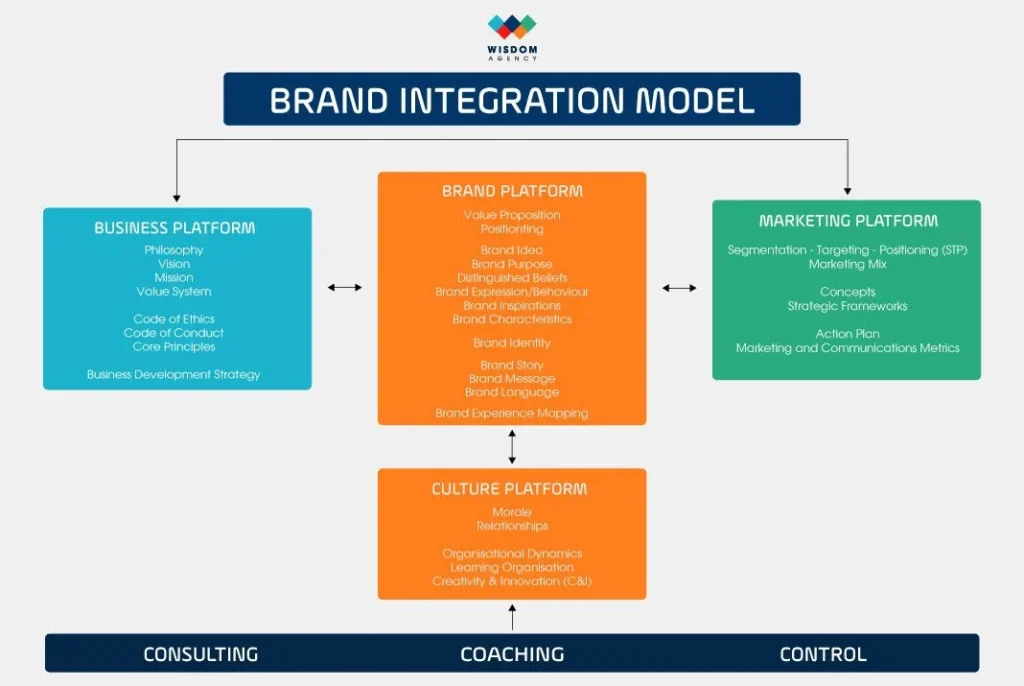
Value Shift and Brand Integration in Huu Nghi Foods’ Business Strategy
Integrating business strategy with the brand can occur at various levels. For Huu Nghi, value shifts took place at a deeply layered level within the structural system, as the company aimed to alter its positioning to expand its business market into the Southern region. It can be said that the most fundamental value shift of Huu Nghi Foods pertained to scaling up from a local business to a nationwide presence.
The story of Huu Nghi Foods and the challenge of expansion to the South
Huu Nghi’s fresh bread products are quite familiar in the Northern region but have yet to gain popularity in the Southern region. Recognizing the potential for growth in the Southern market, expanding to the South was one of the key strategies for Huu Nghi’s product line. However, the challenge of entering the Southern market lay in the fact there were numerous choices for customers, whereas Huu Nghi’s products were relatively fragmented, carrying various different names. If the entire product line were introduced to the South, resources would be separated to small parts, potentially leading to internal competition and making it difficult to create an overall strength to directly confront competitors and target markets.
For this reason, restructuring the brand portfolio was the initial step to strengthen the foundation and build a comprehensive force to support future activities.
More specifically, in the first year, instead of having each product individually “attack the market,” Huu Nghi consolidated the 5 existing bread lines into a leading brand: Staff, this maximized their brand awareness in the market and made consistency in future marketing efforts.
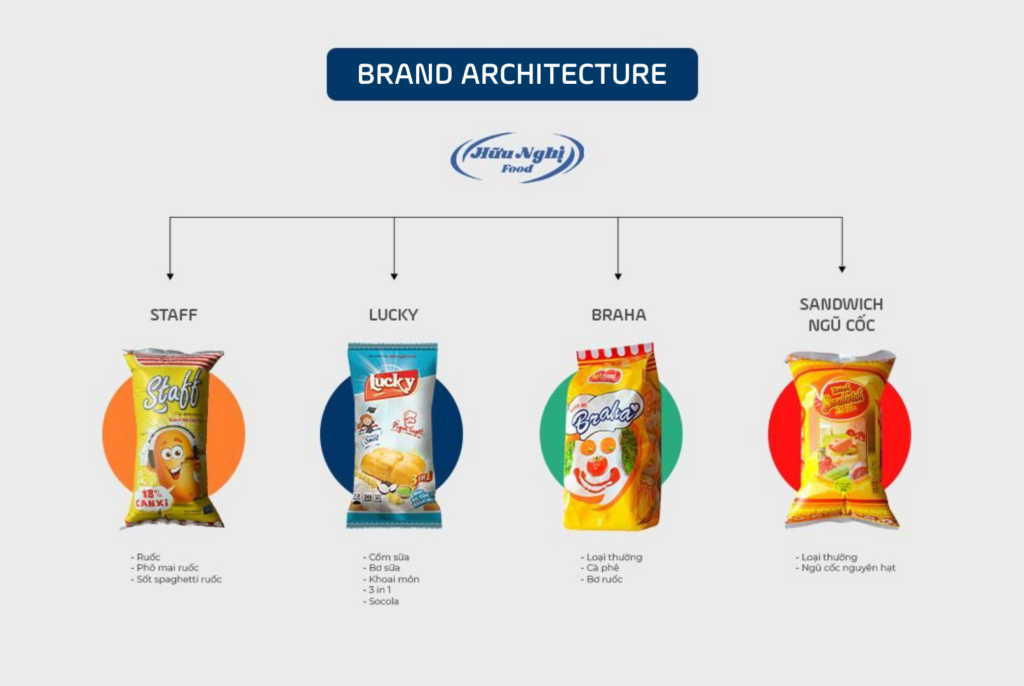
The story of new positioning closely tied to the business strategy
Firstly, there were different preferences from packaging to flavor; from perception to behaviors. For example, during research and consultation, Wisdom observed that there tended to be less loyalty in the Southern market where consumers were triggered by new things, accompanied by more diverse moments of usage and modern taste.
With that in mind, sooner or later Huu Nghi would also need to develop specific product lines for the Southern market. However, the decision on which flavors to develop would depend not only on consumer preferences, but also on the firm’s competitive strategy. What would be the “source of growth” for the Staff fresh bread line, and where would this market share come from?
During consultation, Wisdom and Huu Nghi reached a consensus on the business strategy: ‘Challenge the leader’ – engaging in direct competition with competitors on all fronts. Therefore, Staff would need a broad positioning to integrate existing products and pave the way for the development of new products that are suited for the Southern market.
The positioning of “Nutritious meals on every journey” was created with a multi-tiered message:
- Day journey
- Child-to-adult journey
- North-to-South journey
- All journeys of life
This positioning also changed the market perception of fresh bread products – not only fast and convenient but also tasty and nutritious, being able to provide enough energy on every journey of life.
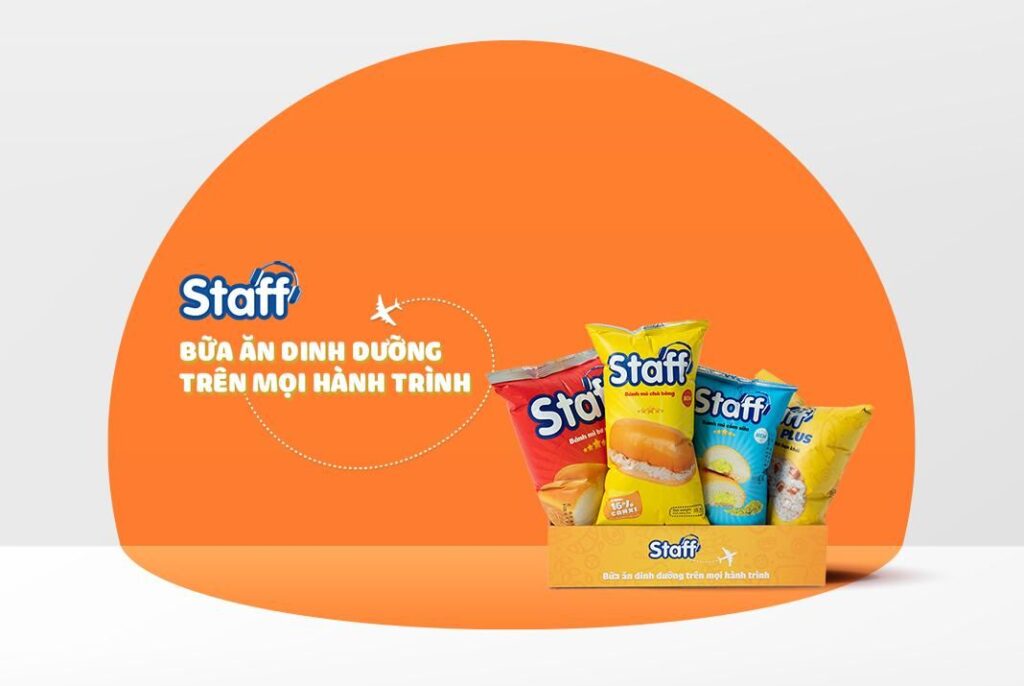
It can be said that Huu Nghi’s core values for the Staff fresh bread line have evolved and matured from a regional brand focusing mainly on the North to nationwide expansion. The positioning of the product line has also shifted from being a daily snack or complementary food to a more organized and sophisticated approach for future extensive development. All of these changes stemmed from a value shift in the company’s perception of the scale it aims to achieve.
The case study of Huu Nghi also concludes the official article series of Wisdom Agency’s Brand Integration Model. The next cases from practical activities at the company will be updated in the business profile and expert profile of Mr. Nguyen Hai Minh.
Practical Case Studies Of Value Shift & Brand Integration
In the previous basic theoretical article, readers had the opportunity to learn about the concept of Value Shift and the practical application of the Brand Integration Model through a single case study from practical activities at Wisdom Agency. To better illustrate this content, I have obtained permission from the client to share our consultancy information in order to contribute to the development of awareness and knowledge within the professional community.
Huu Nghi is an example of the value shift from a regional market to a nationwide presence. Here are two more case studies on Value Shift in the delivery service sector and Value Shift in new positioning establishments, as well as how these shifts impact communication activities and organizational culture development.
Value Shift and Brand Integration into AHT’s public communication activities – the operator of Da Nang International Airport Terminal.
In some cases, Value Shift may not stem from deep layers but rather from surface-level activities, such as external customer-oriented communication efforts. However, these communication activities still need to be rooted in brand positioning so that the messages, even when conveyed through short-term campaigns, can achieve long-term consistency.
Da Nang Airport’s International Terminal (T2) is managed and operated by Da Nang International Terminal Investment and Operation Joint Stock Company (AHT) – also one of the progressive aviation entities that are investing in transforming the image of the destination. We are all familiar with the functional image of airports as places solely for receiving and sending off passengers. However, T2 aspired to go beyond that by pursuing the positioning of a City Airport, which means it aimed to be more than just a place for passengers. It envisioned itself as a destination for the entire city’s residents, a place where people can come, enjoy, shop, and make the most of every moment, whether they are departing or preparing for an upcoming journey.
From such shifts in terms of target audience and functionality, since the beginning of 2023, Da Nang Airport’s International Terminal 2 (T2) has undergone significant changes such as facility enhancement, green spaces renovation, and most recently, the Pink Terminal communication campaign to welcome both the K-Pop group Black Pink and the potential bilateral cooperation activities with Vietnam in the future.
Indeed, to truly become a City Airport, T2 needs to undergo a value shift from being a functional airport to becoming the most hospitable airport terminal in Vietnam. The new value proposition would be more appealing so that not only to passengers but also to the people of Da Nang, who would be enticed to spend their time visiting and experiencing this remarkable place.
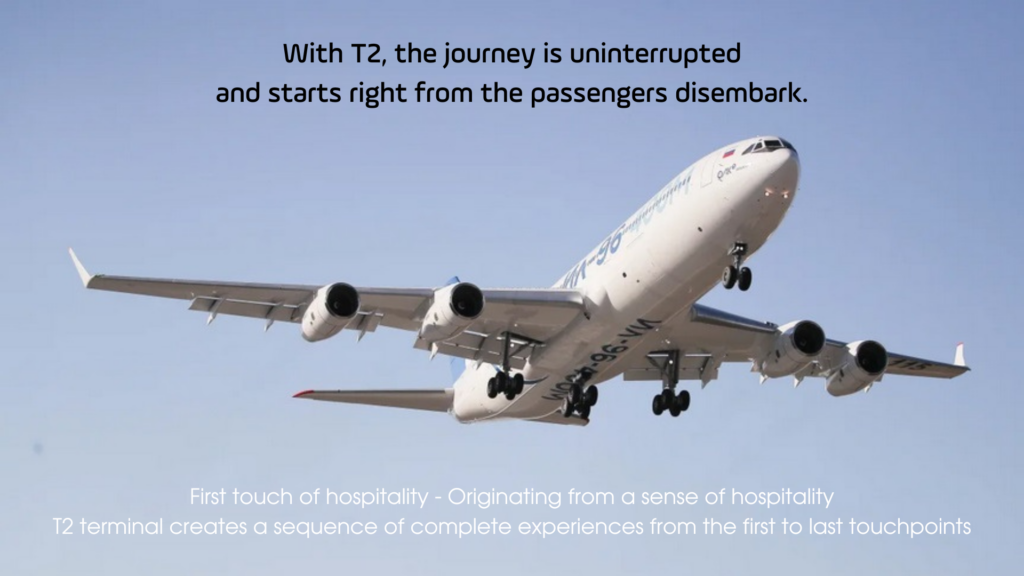
At this time, it is not only the relationship between brand positioning and short-term communication campaigns, usual always-on advertising tactics but also the broader perspective of how the brand communicates with customers, from verbal to non-verbal communication which is changing and becoming more intimate. Passengers or residents of Da Nang can communicate quickly with T2 on social media, while passengers who often face difficulties at the airport can receive dedicated support from the specialized Helper team.
The terminal also places great emphasis on creating a comfortable and joyful space for passengers and residents. Apart from time-sensitive programs such as the Pink Terminal, there are always continuous efforts to improve the green area within the terminal complex, as well as the creation of a mascot character, the seagull, to personify the brand in a friendly manner.
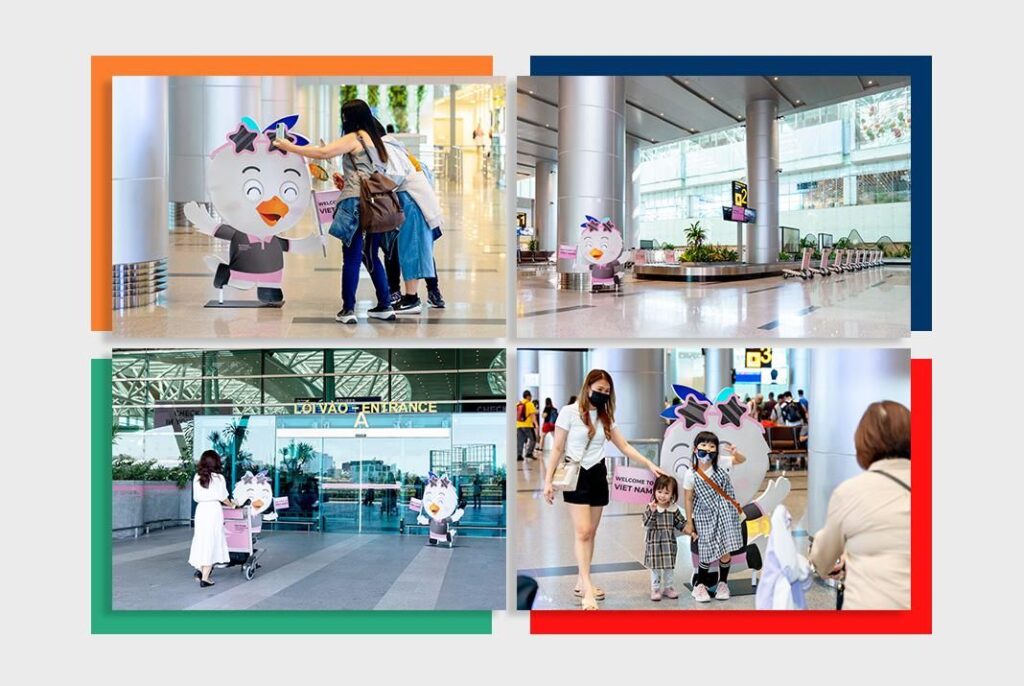
One can say that marketing activities or mass communication are not separate from the profound transformations taking place within the organization. Here, we can see the shift in positioning, target audience, and the purpose of the services provided.
The value shift and brand integration in organizational culture development – Edutalk
In some other cases, value shifts occur quietly and permeate more into the internal operations of a business rather than external communication activities.
From a certain perspective, culture and brand always go hand in hand. If the brand is the outer layer, then culture is the people on the inside. If the brand is how the market perceives the business, then culture is the element that helps align what the business says and does, synthesizing internal strengths to pursue and actualize the brand strategy.
For outsiders to perceive the brand correctly, employees of the business must understand, believe in, and align with it. Ultimately, building a brand is not just about creating an external image but also about fostering an internal culture. If integration and alignment are achieved, the efforts to rebuild the business’s brand will yield outstanding results. Therefore, when the brand has a compelling story to tell, let the entire staff take pride in being a part of it.
In 2022, Edutalk underwent a significant turning point as the business decided to invest in brand development. Transitioning from a specialized platform that connects English learners with course providers, Edutalk expanded by establishing independent brands to offer services. These new brands aimed to have their own strong, distinct positioning while remaining closely connected to the collective efforts of the youthful and dedicated personnel for the company’s growth.
One can say that the decisive factor in building Edutalks brand lies in the development of multiple sub-brands while still maintaining the cohesion of the collective. From a business perspective, we can observe clear value shifts within Edutalk, transforming from a connectivity platform to a multi-solution provider for English language learning needs. In the future, Edutalk’s value positioning also has potential for further development beyond the current English language domain.
With the new message “Edutalk – More than just talk,” it was the business’s declaration of transitioning from a connectivity platform to providing services and continuous customer care in the learning journey. This included various English language learning products such as IELTS, TOEIC, communication skills, and more.
Within the business’s core, a cultural story was also built to unite frontline teams operating in multiple branch centers and support teams serving the development of various brands. The unified internal culture of the business was the story of the “Edutalk Force” inspired by the passion of young staff for the One Piece Grand Voyage and the cohesive, supportive nature of multiple small ships in an invincible fleet.
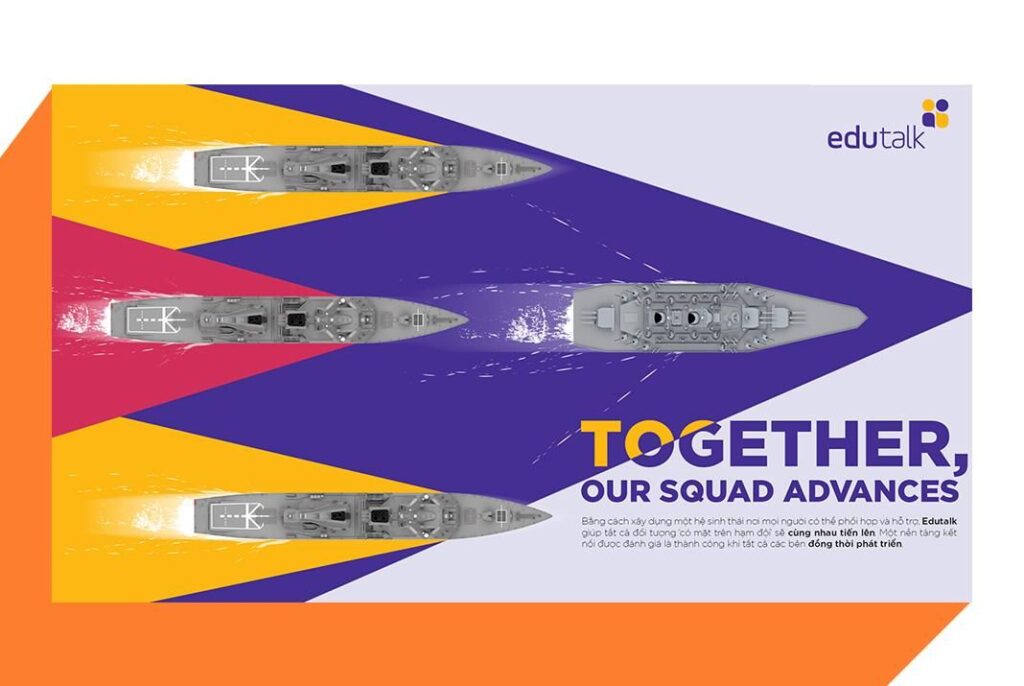
Corresponding communication and internal interaction activities were also developed to connect the two aspects of brand and external, internal communication, and were regularly implemented throughout the year.
Similar to the case studies mentioned above, it can be said that even internal cultural activities have an organic connection with the brand and external communication activities aimed at customers. All these components are inseparable from a deeper value shift within the business structure, in this case, the shifts in business models and service provision.
The concept of Value shift within the business occurs in many aspects. The next case studies will be updated on the Wisdom Agency business profile page and the personal profile of Mr. Nguyen Hai Minh.




